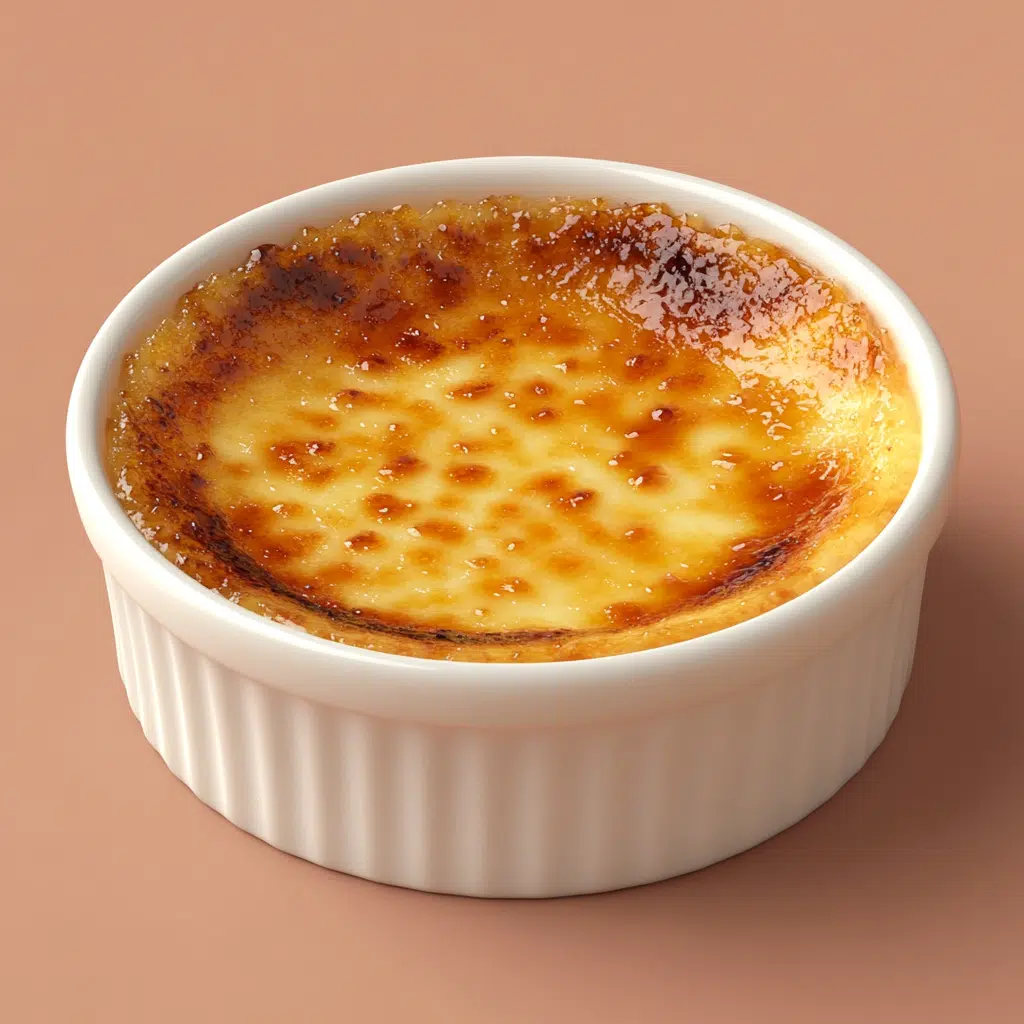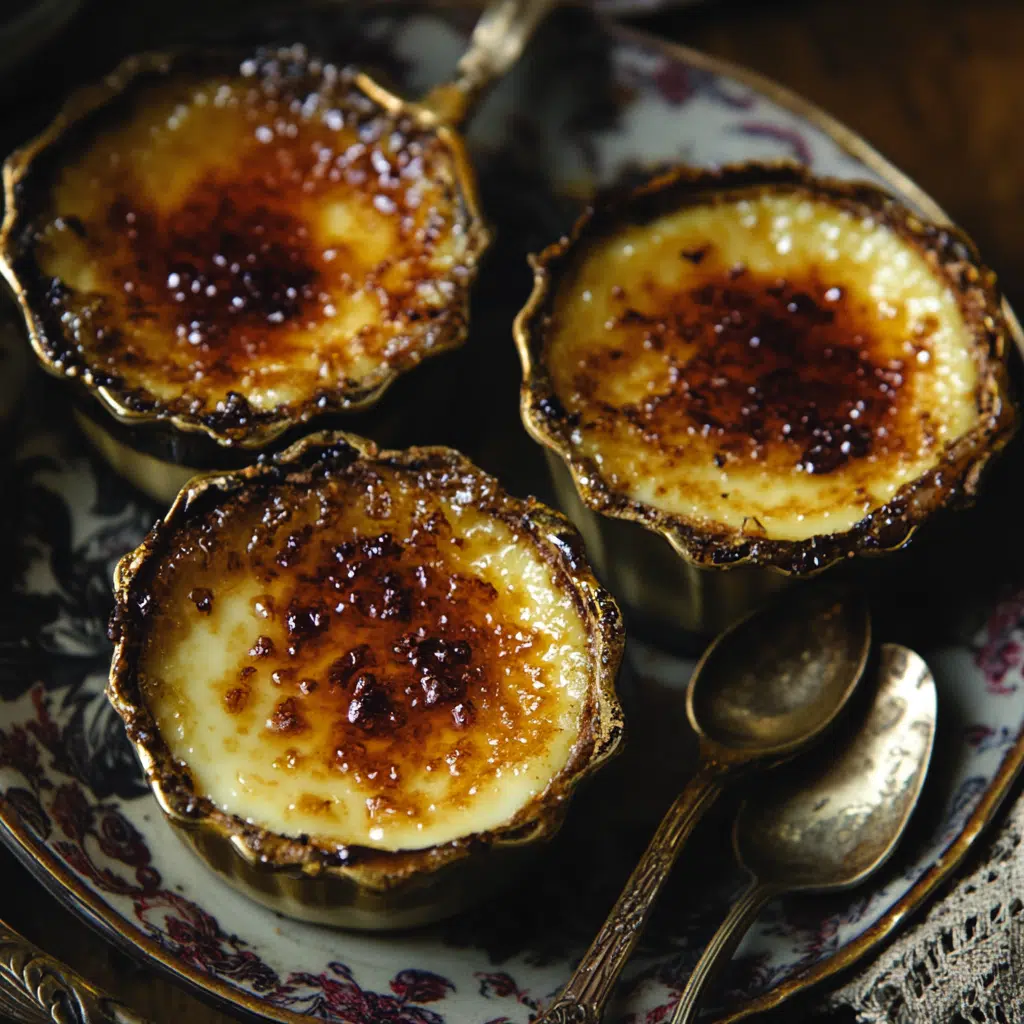Introduction: Unveiling the Iconic Dessert

Crème brûlée is a legendary dessert celebrated for its silky custard base and caramelized sugar crust. The name translates to “burnt cream”, highlighting the essential step of caramelizing sugar on its surface. However, the magic lies not just in the technique but in the quality of ingredients and attention to detail, so, let us discover the secret of crème brûlée.
If you’re eager to try making it yourself, you can find a detailed guide in this classic crème brûlée recipe.
History and Significance of Secret of Crème Brûlée
Origin and Evolution

- The perfect crème brûlée dates back to the 17th century, with its earliest documented appearance in French culinary texts. Its name, meaning “burnt cream,” highlights the defining caramelized sugar topping that sets it apart. Over time, this timeless dessert has inspired variations such as crema catalana in Spain and burnt cream in England, showcasing the widespread appeal and adaptability of the perfect crème brûlée across Europe.
Cultural Significance in French Cuisine
- In France, crème brûlée is considered a hallmark of classic French desserts, symbolizing indulgence and sophistication. Its presence on menus often signifies a chef’s expertise, as it requires both precision and skill. The dessert’s timeless appeal continues to make it a centerpiece of fine dining and celebrations worldwide.
For an in-depth look at how the ingredients shape this iconic dessert, explore what crème brûlée is made of.
The Anatomy of a Perfect Crème Brûlée
Mastering crème brûlée begins with understanding its two essential components: the luxurious custard base and the iconic caramelized sugar topping. Together, they create the perfect harmony of flavors and textures.
The Custard
The custard is the soul of crème brûlée, crafted from a simple yet indulgent combination of heavy cream, egg yolks, sugar, and vanilla. The key to achieving a flawless custard lies in its texture—silky, smooth, and free of air bubbles. Proper technique ensures the custard is rich yet delicate, offering a creamy consistency that melts effortlessly on the palate.
To achieve this, temper the egg yolks by gradually whisking in warm cream to prevent curdling. Strain the mixture through a fine-mesh sieve to remove any lumps and achieve a perfectly smooth texture. Baking the custard in a water bath at a low, consistent temperature prevents overcooking and ensures a tender, custard-like consistency. Infusing the cream with flavors like vanilla bean or other aromatics enhances the depth of flavor while maintaining the classic dessert’s simplicity.
The Caramelized Sugar Topping
The caramelized sugar topping is the crowning glory of a perfect crème brûlée, providing a dramatic contrast to the creamy custard beneath. Made by sprinkling a thin, even layer of granulated sugar over the chilled custard, the topping is then caramelized using a culinary torch or broiler.
The perfect caramelized sugar crust is golden-brown, slightly glassy, and brittle, cracking under the gentle tap of a spoon. Achieving this requires even torching to avoid burning or under-caramelizing the sugar. Use fine sugar for a smoother caramelization process, ensuring that the layer is not too thick, as it can overpower the custard. The combination of the sweet, brittle topping and the creamy custard creates the signature texture and flavor pairing that makes a perfect crème brûlée unforgettable.
By perfecting these two elements, you’ll master the art of crafting a Perfect crème brûlée that delights with every spoonful.
Curious about its taste? Learn more about what crème brûlée tastes like.
The Secret of Crème Brûlée
High-Quality Ingredients
- Use fresh eggs and premium vanilla beans for a richer flavor.
- Substitute heavy cream with alternatives cautiously, as it affects texture.
Techniques to Master
- Tempering the Eggs
- Prevent curdling by gradually introducing warm cream into whisked yolks.
- Water Bath Baking
- Ensure even cooking and a silky texture by placing ramekins in a water bath.
- Sugar Caramelization
- Use a kitchen torch for precision or a broiler for an even caramelization.
Techniques and Tools
Traditional Tools
- Blowtorches: Essential for achieving the signature caramelized sugar topping with precision and control.
- Ramekins: Shallow, wide ramekins are ideal for even baking and creating the perfect custard-to-topping ratio.
Modern Innovations in Preparation
- Sous Vide Techniques: This method ensures a consistent custard texture without the risk of overcooking.
- Broilers and Electric Torches: Convenient alternatives to traditional blowtorches for caramelizing the sugar topping.
Common Mistakes to Avoid
Overcooking the Custard
- Overcooking results in a grainy texture instead of the desired silky smoothness. Always bake the custard until it slightly jiggles when gently shaken.
Failing to Achieve the Caramelized Crust
A proper crisp sugar layer requires even torching. Failing to caramelize evenly may leave sections burnt or undercooked. Use consistent, circular motions with the torch to avoid these issues.
Flavor Variations
Elevate the classic perfect crème brûlée with these irresistible twists that bring new dimensions to this beloved dessert. Whether you’re looking for bold, refreshing, or subtle flavors, these creative variations are sure to impress:
- Chocolate Crème Brûlée: Transform the traditional recipe into a rich and indulgent treat by adding high-quality cocoa powder or melted dark chocolate to the custard. The result is a silky, chocolate-infused base paired with the iconic caramelized topping—a chocolate lover’s dream!
- Citrus Infusion: Brighten up the custard with a burst of citrus flavor by adding the zest of lemon, lime, or orange. This refreshing twist balances the sweetness of the dessert with a subtle tang, making it perfect for spring and summer gatherings.
- Lavender or Rose: Infuse your custard with a hint of floral elegance by steeping dried lavender buds or rose petals in the cream before mixing. These aromatic additions create a sophisticated flavor profile that’s both delicate and unique.
- Espresso Crème Brûlée: Add a shot of espresso or a spoonful of instant coffee to the custard mixture for a rich, coffee-flavored version. This variation pairs beautifully with the caramel notes of the sugar topping.
- Vanilla Bean: While vanilla is a classic, using real vanilla bean pods elevates the flavor to a whole new level. The specks of vanilla throughout the custard add depth and visual appeal.
- Spiced Delight: Enhance the custard with warm spices like cinnamon, nutmeg, or cardamom for a cozy and aromatic twist. This variation is perfect for the holiday season.
- Tropical Touch: Incorporate coconut milk into the custard or garnish with toasted coconut flakes for a tropical-inspired version. You can even add a hint of pineapple or passion fruit for extra zest.
- Matcha Crème Brûlée: Blend matcha green tea powder into the custard for a vibrant, earthy flavor and a stunning green hue. This Japanese-inspired variation is a favorite among tea enthusiasts.
- Salted Caramel: Take caramel to the next level by adding a pinch of sea salt to the custard or topping. The sweet and salty contrast creates a flavor explosion in every bite.
- Berry Bliss: Swirl pureed raspberries, strawberries, or blackberries into the custard before baking for a fruity burst of flavor. This variation adds a refreshing tartness to the creamy dessert.
Each of these variations enhances the traditional crème brûlée while maintaining its hallmark creamy texture and caramelized sugar topping. Experiment with these ideas to find your favorite version!
For more adventurous takes, explore crab brûlée recipes to see how brûlée techniques are used in savory contexts.
Serving the Perfect Crème Brûlée
Presentation Tips
- Serve crème brûlée in shallow ramekins to showcase the caramelized sugar topping and enhance visual appeal.
- Garnish with fresh berries, a sprig of mint, or a light dusting of powdered sugar to add a touch of elegance.
- Use a decorative serving tray to elevate the dessert’s sophistication during special occasions.
Pairing with Wines and Desserts
For coffee lovers, a cup of espresso or a creamy latte can beautifully enhance the dessert experience.
Complement the richness of crème brûlée with a dessert wine like Sauternes or a sparkling Moscato.
Pair it with light desserts such as fruit tarts or lemon sorbet to balance the creamy texture and sweet flavor.
Common Mistakes to Avoid for a Perfect Crème Brûlée
Overcooking the Custard
- Overcooking can ruin the silky texture of your custard, leaving it grainy and unpleasant. To avoid this, bake until the custard gently jiggles in the center when shaken. For precise instructions on creating the perfect custard, refer to what crème brûlée is made of.
Failing to Achieve the Caramelized Crust
- A properly caramelized sugar crust is a defining feature of crème brûlée. Failing to torch evenly can result in burnt or uneven layers. Keep the torch moving in circular motions for a uniform caramelization. For more tips, check out this step-by-step crème brûlée recipe.
By avoiding these common mistakes, you can consistently craft a flawless dessert every time!
FAQs About a Perfect Crème Brûlée
What makes a good crème brûlée?
A good crème brûlée balances a rich, silky custard base with a crisp caramelized sugar topping. The custard should be creamy and infused with flavors like vanilla or citrus, while the sugar crust should crack under a spoon to provide a satisfying textural contrast. Using high-quality ingredients such as fresh eggs, heavy cream, and premium vanilla is essential.
For a detailed recipe to make the perfect custard, check out what crème brûlée is made of.
How to get the perfect crème brûlée top?
The perfect caramelized sugar topping is achieved by evenly sprinkling granulated sugar on top of the chilled custard and using a kitchen torch to caramelize it. Keep the torch moving in circular motions to ensure an even melt and prevent burning. The result should be a thin, glass-like crust that adds a delightful crunch to the dessert.
If you’re looking for step-by-step guidance, refer to this classic crème brûlée recipe.
What creates the hard top on a crème brûlée?
The hard top of a crème brûlée is created by caramelizing sugar with high heat. The sugar melts and then hardens as it cools, forming a crisp layer. This step is typically done with a culinary torch, though a broiler can also be used. The caramelized layer contrasts beautifully with the creamy custard base, creating the dessert’s signature texture.
Curious about its flavor profile? Discover what crème brûlée tastes like.
What is the brown stuff on crème brûlée?
The brown topping on crème brûlée is the caramelized sugar layer. This is achieved by melting granulated sugar until it turns golden brown and forms a hard crust. It’s not burnt but rather intentionally browned to bring out deep, complex flavors that enhance the dessert’s sweetness.
Let me know if you’d like further elaboration on any of these points!
Troubleshooting Common Issues
- Curdled Custard: Avoid overheating the mixture during tempering.
- Uneven Sugar Layer: Keep the torch moving evenly to prevent burning.
- Texture Problems: Ensure the water bath fully surrounds the ramekins.
Conclusion
Why Crème Brûlée Remains Timeless
- Crème brûlée is a timeless classic, cherished for its elegance, simplicity, and the delightful contrast between its creamy custard and caramelized topping. Its rich history and versatility in flavors have made it a beloved dessert across generations.
Encouragement to Try Making It at Home
- Creating crème brûlée at home is a rewarding experience, offering both a culinary challenge and the satisfaction of crafting a restaurant-quality dessert. By mastering its simple yet precise techniques, you can elevate your skills and impress your guests with this iconic treat.
Dive in, experiment with flavors, and enjoy the magic of crème brûlée!

